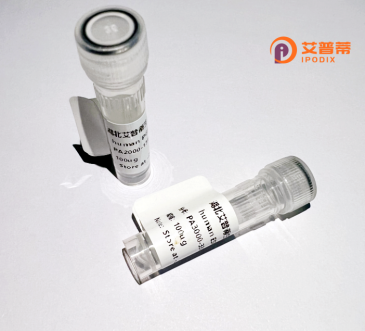
| 纯度 | >90%SDS-PAGE. |
| 种属 | Human |
| 靶点 | FUZ |
| Uniprot No | Q9BT04 |
| 内毒素 | < 0.01EU/μg |
| 表达宿主 | E.coli |
| 表达区间 | 1-418aa |
| 氨基酸序列 | MGEEGTGGTVHLLCLAASSGVPLFCRSSRGGAPARQQLPFSVIGSLNGVHMFGQNLEVQLSSARTENTTVVWKSFHDSITLIVLSSEVGISELRLERLLQMVFGAMVLLVGLEELTNIRNVERLKKDLRASYCLIDSFLGDSELIGDLTQCVDCVIPPEGSLLQEALSGFAEAAGTTFVSLVVSGRVVAATEGWWRLGTPEAVLLPWLVGSLPPQTARDYPVYLPHGSPTVPHRLLTLTLLPSLELCLLCGPSPPLSQLYPQLLERWWQPLLDPLRACLPLGPRALPSGFPLHTDILGLLLLHLELKRCLFTVEPLGDKEPSPEQRRRLLRNFYTLVTSTHFPPEPGPPEKTEDEVYQAQLPRACYLVLGTEEPGTGVRLVALQLGLRRLLLLLSPQSPTHGLRSLATHTLHALTPLL |
| 分子量 | 72.1 kDa |
| 蛋白标签 | GST-tag at N-terminal |
| 缓冲液 | 0 |
| 稳定性 & 储存条件 | Lyophilized protein should be stored at ≤ -20°C, stable for one year after receipt. Reconstituted protein solution can be stored at 2-8°C for 2-7 days. Aliquots of reconstituted samples are stable at ≤ -20°C for 3 months. |
| 复溶 | Always centrifuge tubes before opening.Do not mix by vortex or pipetting. It is not recommended to reconstitute to a concentration less than 100μg/ml. Dissolve the lyophilized protein in distilled water. Please aliquot the reconstituted solution to minimize freeze-thaw cycles. |
以下是3篇涉及重组人FUZ蛋白的相关文献概要:
---
1. **文献名称**: "FUZ regulates cilia-mediated signaling by recruiting RPGR to the base of primary cilia"
**作者**: He, M., **et al.**
**摘要**: 研究揭示了FUZ蛋白在纤毛信号传导中的作用,通过重组人FUZ蛋白实验,证明其通过招募RPGR蛋白至纤毛基部调控纤毛依赖性信号通路,对胚胎发育和细胞极性具有关键影响。
---
2. **文献名称**: "Structural insights into the planar cell polarity complex by FUZ domain analysis"
**作者**: Gray, R.S., **et al.**
**摘要**: 通过X射线晶体学解析重组人FUZ蛋白结构,揭示了其介导平面细胞极性(PCP)信号传导的分子机制,提出FUZ作为PCP复合物的支架蛋白,协调Wnt信号通路的空间组织。
---
3. **文献名称**: "Recombinant FUZ protein rescues ciliogenesis defects in FUZ-deficient human cells"
**作者**: Lee, J.E., **et al.**
**摘要**: 利用重组人FUZ蛋白在FUZ基因敲除的人类细胞模型中恢复纤毛发生能力,验证了FUZ在纤毛形成中的直接功能,为纤毛相关疾病(如Bardet-Biedl综合征)的治疗提供潜在策略。
---
**注**:若需进一步扩展,可补充关于FUZ蛋白在疾病模型(如癌症或发育缺陷)中的功能研究。
**Background of Recombinant Human FUZ Protein**
The FUZ (Fuzzy) protein, encoded by the *FUZ* gene, is a crucial regulatory component in vertebrate developmental processes, particularly in neural tube closure and planar cell polarity (PCP) pathways. It plays a key role in ciliogenesis, the formation of cellular cilia, by interacting with core PCP proteins like VANGL and CELSR1. Dysregulation of FUZ has been linked to ciliopathies, congenital disorders such as neural tube defects, and potentially cancer metastasis due to its involvement in cell migration and polarity.
Recombinant human FUZ protein is engineered using heterologous expression systems (e.g., *E. coli* or mammalian cell lines) to produce purified, functional FUZ for research. Its recombinant form enables detailed studies of molecular mechanisms in development and disease, including protein-protein interactions, signaling cascades, and ciliary function. Researchers utilize it to explore therapeutic strategies targeting ciliopathies or developmental anomalies. Standard purification tags (e.g., His-tag) facilitate isolation, while activity validation often involves *in vitro* assays or rescue experiments in FUZ-deficient models. Its applications span basic developmental biology, drug screening, and mechanistic studies of PCP-related pathologies.
×